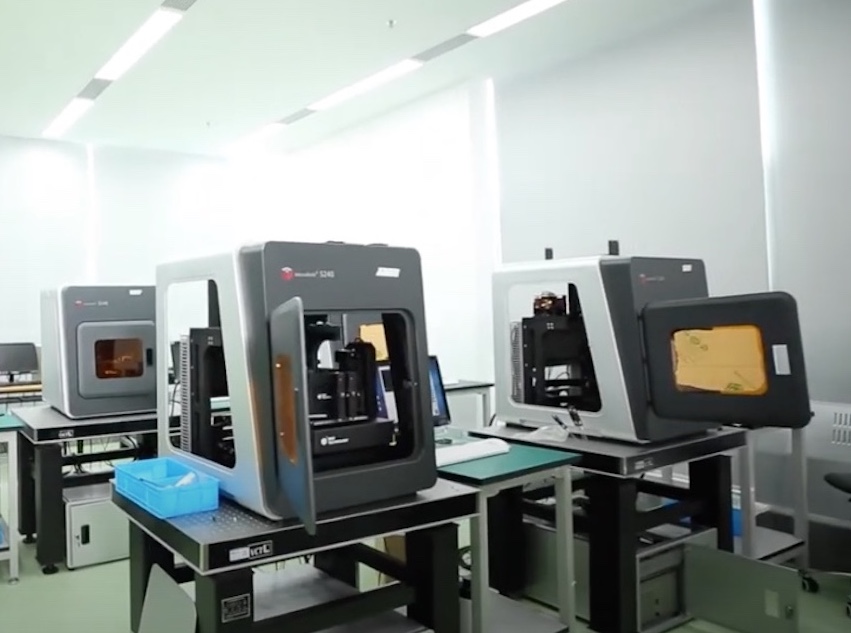Watch the 2022 3D Printing Industry Awards Live on Tuesday, 13th December: subscribe and enable notifications.
Microfabrication start-up Horizon Microtechnologies has launched a new microscale 3D printing technology at the Formnext tradeshow.
The firm’s template-based micro-additive manufacturing or ‘micro-AM’ process enables the creation of conductive parts with micrometer-level precision. Having brought its technology to market, the firm says it could now help bring greater manufacturing versatility to the production of electrodes, electrical contact pins, ESD-safe parts, microfluidic devices, MEMS, and optics packaging for the first time.
“Template-based 3D microfabrication is effectively a mechanism to exploit the usefulness of polymer micro-AM produced 3D microstructures (the template) for hitherto unserved areas of industry. This is a real game-changer,” explains the firm’s CEO Andreas Frölich. “Horizon Microtechnologies bridges the gap between micro-AM and parts with enhanced functionality through the use of proprietary post-build processes.”

Template-Based 3D Microfabrication
Horizon Microtechnologies specializes in the development of template-based 3D microfabrication, a microscale 3D printing technology. Compared to the parts produced by existing offerings in this area, the firm says those manufactured via its technology feature enhanced functionality thanks to its post-build processes.
This not only means that users can switch up their deployment of parts by providing them with desirable properties like heat resistance, but they can microscale print with metals and ceramics, in a way that unlocks functionalities like conductivity.
To achieve this, the technology wholly or selectively coats parts produced via polymer 3D printing with a conductive layer. Interestingly, the process is even able to get to difficult-to-coat areas like long narrow channels and undercuts and create complex electrodes, electrical sensor heads or ESD-safe components.
“The key enabling technology for our processes is micro-AM, and today a number of commercially viable polymer-based micro-AM platforms exist that can achieve exacting tolerances, quickly, cost-effectively, and above all repeatably,” adds Frölich. “However, these platforms are almost exclusively restricted to the production of parts in resin or plastics.”

Putting micro-AM into practice
At Formnext, Frölich launched its technology alongside fellow micro-3D printing innovator Boston Micro Fabrication. As he presented the process to industry leaders, the company’s CEO explained how microfabricated 3D templates can also be coated with metal oxides, to prepare parts for use in hostile environments where chemicals are present.
In practice, this enables the creation of complex nozzles and microfluidic devices for use around aggressive solvents and certain acids. The latter, in particular, are said to benefit from Horizon Microtechnologies’ post-print processes, which allow for the surfaces in contact with liquids to be coated. These can also help improve wetting behavior, control surface energy, and be used to introduce conductivity.
Elsewhere, when it comes to producing ESD-safe parts, Horizon Microtechnologies’ process is capable of controllably coating conductive surfaces, including those hidden inside internal channels. This makes the technology especially useful for manufacturing compact, high-performance end-effectors for vacuum pick-and-place devices, which are conductive enough to prevent ESD discharge.
In addition to marketing its micro-AM technology via contract manufacturing services, Horizon Microtechnologies now offers to help customers with R&D as a development partner. Drawing on its unique understanding of 3D microfabrication, including its 2PP and atomic layer deposition 3D printing experience, the firm aims to help customers get from design to prototype or even mass production.

Horizon Microtechnologies shared the stage at Formnext with one of the highest-profile microfabrication specialists in the industry. In July this year, Boston Micro Fabrication raised $43 million in Series C funding to support its plans to double its global install base, invest in product R&D and build out its marketing team.
The likes of 2PP additive manufacturing specialist Nanoscribe have also made their mark in the industry, and it launched the Quantum X align 3D printer in January 2022. At launch, the firm’s high-precision microprinter was reportedly the first of its kind to be capable of printing freeform micro-optical elements onto optical fibers and photonic chips.
To stay up to date with the latest 3D printing news, don’t forget to subscribe to the 3D Printing Industry newsletter or follow us on Twitter or liking our page on Facebook.
While you’re here, why not subscribe to our Youtube channel? featuring discussion, debriefs, video shorts and webinar replays.
Are you looking for a job in the additive manufacturing industry? Visit 3D Printing Jobs for a selection of roles in the industry.
Featured image shows a Horizon Microtechnologies-3D printed electronic device. Photo via Horizon Microtechnologies.



